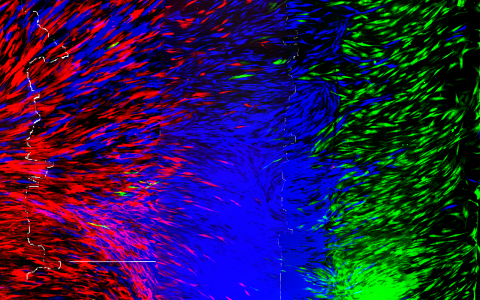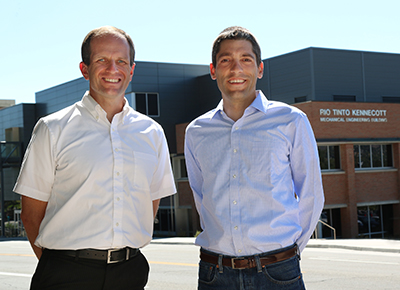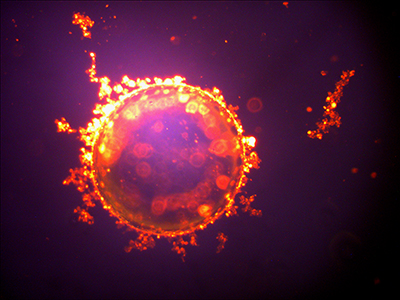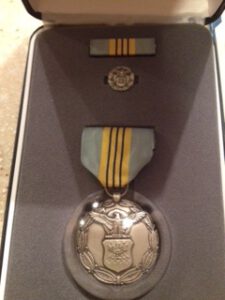Mechanical Engineering Research Assistant Professor Himanshu Sant, received a $235,435 grant from Microsurgical Innovations (Prime sponsor NIH), for his research, “A Biodegradable Vascular coupling Device for End-to-End Anastomosis.”
Gale Receives Mayo Clinic Grant
Mechanical Engineering professor Bruce Gale received $67,750, from the Mayo Clinic for his research, “Development of a Whole Genome Amplification (WGA) Cell Analysis and Selection Instrument.”
3D Printing Human Ligaments, Tendons and More . . .
With today’s technology, we can 3-D-print sculptures, mechanical parts, prosthetics, teeth, even guns and food. But a team of University of Utah biomedical engineers have developed a method to 3-D-print cells to produce human tissue such as ligaments and tendons, a process that will greatly improve a patient’s recovery.
A person with a badly damaged ligament, tendon, or ruptured disc could simply have new replacement tissue printed and ultimately implanted in the damaged area, according to a new paper published in the Journal of Tissue Engineering, Part C: Methods.
“It will allow patients to receive replacement tissues without additional surgeries and without having to harvest tissue from other sites, which has its own source of problems,” says University of Utah biomedical engineering assistant professor Robby Bowles, who co-authored the paper along with former U biomedical engineering master’s student, David Ede.
The 3-D-printing method, which took two years to research, involves taking stem cells from the patient’s own body fat and printing them on a layer of hydrogel to form a tendon or ligament which would later grow in vitro in a culture before being implanted. But it’s an extremely complicated process because that kind of connective tissue is made up of different cells in complex patterns. For example, cells that make up the tendon or ligament must then gradually shift to bone cells so the tissue can attach to the bone.
“This is a technique in a very controlled manner to create a pattern and organizations of cells that you couldn’t create with previous technologies,” Bowles says of the printing process. “It allows us to very specifically put cells where we want them.”

To do that, Bowles and his team worked with Salt Lake City-based company, Carterra, Inc., directed by mechanical engineering professor and chair Bruce Gale, which develops microfluidic devices for medicine. Researchers used a 3-D printer from Carterra typically used to print antibodies for cancer screening applications. But Bowles’ team developed a special printhead for the printer that can lay down human cells in the controlled manner they require. To prove the concept, the team printed out genetically-modified cells that glow a fluorescent color so they can visualize the final product (pictured, below).
Currently, replacement tissue for patients can be harvested from another part of the patient’s body or sometimes from a cadaver, but they may be of poor quality. Spinal discs are complicated structures with bony interfaces that must be recreated to be successfully transplanted. This 3-D-printing technique can solve those problems.
Bowles, who specializes in musculoskeletal research, said the technology currently is designed for creating ligaments, tendons and spinal discs, but “it literally could be used for any type of tissue engineering application,” he says. It also could be applied to the 3-D printing of whole organs, an idea researchers have been studying for years. Bowles also says the technology in the printhead could be adapted for any kind of 3-D printer.
3D Printing of Tendons and Ligaments
U Profs Receive $16M to Launch New MEP Center
 Mechanical Engineering associate professor Bart Raeymaekers and professor Bruce Gale receive $16 million in funding over the next five years from both federal and state governments as well as local industry to develop a new center to help local manufacturing businesses succeed.
Mechanical Engineering associate professor Bart Raeymaekers and professor Bruce Gale receive $16 million in funding over the next five years from both federal and state governments as well as local industry to develop a new center to help local manufacturing businesses succeed.
One of the hot-button issues this presidential election is about companies outsourcing work overseas and figuring out how to keep manufacturing jobs here in America. To help convince these businesses they can perform better in their own backyard, two University of Utah mechanical engineering professors are establishing a center to show local manufacturing companies how they can spur innovation and utilize the latest in technology.
The new University of Utah Manufacturing Extension Partnership (MEP) Center will deliver services for small and medium-sized manufacturing companies by providing expertise in advanced manufacturing technology, innovation, worker education, operational excellence, and on how to connect companies with investor opportunities.
“The goal of the program is to provide these services so businesses can remain competitive against cheap overseas labor and to keep those manufacturing jobs here,” says University of Utah mechanical engineering associate professor Bart Raeymaekers, who along with mechanical engineering professor Bruce Gale are creators of the center and recipients of the grant.
The center, in partnership with other entities and organizations throughout the state, will help local businesses:
- Use data to identify products and markets that are growing and provide resources for the prototyping of new products.
- Implement advanced manufacturing equipment and technology.
- Develop and educate their workforce to use these new technologies.
- Connect with investors and secure government grants to increase funding.
- Learn how to make their operations more efficient to maximize profits.
The University of Utah’s MEP Center will receive funding from the U.S. commerce department’s National Institute of Standards and Technology (NIST) and the Utah Governor’s Office of Economic Development (GOED). All told, the center will receive $16 million in funding over the next five years from both federal and state governments as well as local industry. Utah is one of 11 states and Puerto Rico to have received NIST funding this month for local MEP centers.
The Utah center, which will be under the U’s College of Engineering, will begin operations Oct. 1 and be headquartered on the U campus. It will employ at least a dozen permanent employees, consultants and industry professionals. It will open satellite offices in Cache and Utah counties as well as have consultants in eastern Utah and Cedar City.
There are more than 3,300 manufacturing companies in Utah, ranging in areas from chemical products and computer and electronic products to metals, aerospace equipment and food products, according to publicly available data.
NIH Features U Student Research

NIH – Snapshots of Life: A Flare for the Dramatic: Oil and water may not mix, but under the right conditions—like those in the photo above—it can sure produce some interesting science that resembles art. You’re looking at a water droplet suspended in an emulsion of olive oil (black and purple) and lipids, molecules that serve as the building blocks of cell membranes. Each lipid has been tagged with a red fluorescent marker, and what look like red and yellow flames are the markers reacting to a beam of UV light. Their glow shows the lipids sticking to the surface of the water droplet, which will soon engulf the droplet to form a single lipid bilayer, which can later be transformed into a lipid bilayer that closely resembles a cell membrane. Scientists use these bubbles, called liposomes, as artificial cells for a variety of research purposes.
Alum Receives Second Highest Civilian Award from Air Force
For his steadfast dedication to the mission of the Space Superiority Systems Directorate, Mechanical Engineering alum, Mark Eddings B.S.’04, received the Meritorious Civil Service Award, from the Los Angeles Air Force. Noted was the the fact that many of the advances over the past two years were spearheaded under Dr. Eddings’ leadership.
The Meritorious Civil Service Award is the second highest award a civilian can receive in the Air Force. This is especially remarkable when considering Mark has only worked for the Air Force for five years.
Mark A. Eddings was born and raised in Bountiful, Utah. He attended Bountiful High School where he graduated in 1997. After serving a two-year LDS mission to the Fiji Islands, he returned home and began studying Mechanical Engineering at the University of Utah. He graduated in May of 2004 with a Bachelor’s Degree in Mechanical Engineering and received his PhD in Bioengineering.
Research work while working with mechanical engineering professor Bruce Gale in the Biomedical Microfluidics Lab include:
- Development of a painless drug delivery system using microneedles. The project utilized photolithography, wet etching, electroplating, and other MEMS processes.
- Development of micropumps for on-chip fluidic control for biosensors and protein spotting applications. Work was focused on PDMS-based peristaltic and permeation/diffusion pumps.
- Development of highly arrayed continuous flow immunoassays in a microfluidic device.
- Development of an ELISA assay for detection of antibodies to drug treatments given to Multiple Sclerosis (MS) patients.
The Department of Mechanical Engineering at the University of Utah is committed to providing students with broad-based, rigorous and progressive education. By combining state-of-the-art facilities with renowned faculty, the department provides an education that gives students the necessary skills to become the next generation of innovators.
Gale Named 2014 Distinguished Mentor
 Mechanical engineering professor Bruce K. Gale has been named a 2014 Graduate Student and Postdoctoral Scholar Distinguished Mentor by the University of Utah Graduate School. Gale was recognized during the 2014 College of Engineering convocation ceremony on May 2.
Mechanical engineering professor Bruce K. Gale has been named a 2014 Graduate Student and Postdoctoral Scholar Distinguished Mentor by the University of Utah Graduate School. Gale was recognized during the 2014 College of Engineering convocation ceremony on May 2.
The $2,500 award recognizes faculty for effectively guiding students and fellows through professional and educational training. Gale is one of three award recipients this year, along with Matthew Mulvey (pathology) and Timothy W. Smith (psychology).
Engineering graduate students, postdoctoral scholars, alumni and colleagues nominated Gale for the honor, citing his devotion, appreciation for diversity and ability to individually tailor guidance.
“I am very honored and grateful to be nominated,” says Gale. “I am overwhelmed that so many thought so highly of my efforts, as there are many excellent mentors within the College of Engineering,” says Gale.
Gale was praised for his accessibility despite holding several university leadership positions, including director of the State of Utah Center of Excellence for Biomedical Microfluidics. He was also lauded for creating a supportive environment through weekly meetings that enable student researchers to present ideas and discuss barriers.
“Mentoring has helped me recognize the gifts and talents of many students, and that every student can make a contribution to science and engineering,” says Gale. “Recognition should also go to my great students and postdocs who make mentoring easy for me. I better appreciate the uniqueness and value of many more people, approaches and cultures.”
To receive the award, a mentor must have a record of guiding students to degree completion. Gale has graduated 13 Ph.D. and 27 M.S. students, advised six postdoctoral researchers and mentored dozens of undergraduates. He currently advises 11 Ph.D. and two M.S. students.
Exosomes
Mechanical Leech Selected as National Finalist
THE SECRET IS OUT! The national Collegiate Inventors Competition formally announced that the University of Utah’s Mechanical Leech team is among their elite finalists.
The Collegiate Inventors Competition is a national competition that recognizes and rewards innovations, discoveries, and research by college and university students and their faculty advisors. Entries are judged on the originality and inventiveness of the new idea, process, or technology. Entries are also judged on their potential value to society (socially, environmentally, and economically), and on the scope of use.
Advised by mechanical engineering professor Bruce Gale (director of the Center of Excellence for Biomedical Microfluids at the University of Utah) and University of Utah School of Medicine surgeon, Dr. Jay Agarwal (assistant professor in the Department of Surgery, Division of Plastic Surgery and Huntsman Cancer Institute Investigator), mechanical engineering students Andy Thompson, Scott Ho and Jessica Kuhlman (B.S. 2013), chose the Mechanical Leech project as their senior capstone design.
Agarwal is interested in leech therapy for some of his patients and proposed the idea of a reliable functioning mechanical leech device to Dr. Bruce Gale. Gale felt it would make a nice undergraduate senior capstone project.
The University of Utah Mechanical Leech mimics the functions of the biological leeches used in leech therapy. The Mechanical Leech is currently about 1” (25mm) in diameter plus additional tubing, and will eventually offer numerous size variations to accommodate the doctors’ needs. The primary customers for the Mechanical Leech are intended to be doctors and surgeons.
The completed device will provide a suitable replacement for the biological leech by reducing excess fluidic pressure and injecting an anti-coagulant into patients. In addition to eliminating a patient’s adverse reaction to biological leeches, a Mechanical Leech will be able to provide more consistent, controllable performance over its parasitic counterpart, making it more desirable to doctors and surgeons to use during therapy.
Alongside 22 other senior design projects, the Mechanical Leech team showcased their finished product during the Department of Mechanical Engineering Design Day last April. It was one of three projects to receive a Boeing Distinguished Project Award. Additionally, last April they finished as the runner up at the Bench to Bedside competition at the Huntsman Cancer Institute where they received a $10,000 cash award.
“Mechanical Leech was in my top five project choices, but I didn’t really know what the project would be like; the title is what caught me,” says Jessica Kuhlman. “We were going to be solving a real world problem and that is the main reason I wanted to go into engineering. After the team got together, we met with Dr. Agarwal, who was crucial to our coming up with the design. Having a surgeon that has used leeches and be able to tell us how the device needs to function was very helpful. He was also a great resource regarding our potential future customers and what would make the device better and, from the doctors’ view point, more user friendly.”
“The thing that is most rewarding about this project is the scope of the project,” noted Scott Ho. “We were able to go from a product and field research stage to exploring commercialization and really consider all aspects of the engineering process. It was a project that had a practical application in the medical field and our role in the project encompassed the entire device, not just a small section of a system”
The national Collegiate Inventors Competition encourages students who actively pursue invention. Students frequently come from science, engineering, mathematics, and technology studies but creative invention can emerge from any course of study. The Competition also recognizes the working relationship between a student and his or her advisor.
Introduced in 1990, the Collegiate Inventors Competition has recognized, rewarded, and encouraged hundreds of students to share their inventive ideas with the world. The Competition promotes exploration in invention, science, engineering, technology, and other creative endeavors and provides a window on the technologies from which society will benefit in the future.
Each year, the finalists (or finalist teams) in the Graduate and Undergraduate Divisions receive all-expense paid trips to present their work to a panel of expert judges in Washington, D.C.
http://www.invent.org/collegiate/finalists_2013.html
The Department of Mechanical Engineering at the University of Utah is committed to providing students with broad-based, rigorous and progressive education. By combining state-of-the-art facilities with renowned faculty, the department provides an education that gives students the necessary skills to become the next generation of innovators.
Department Researcher of the Year 2012 – Bruce Gale
 Based on faculty activity report scholarship, as well as proposal and grant data, we are pleased to recognize Prof. Bruce Gale as our researcher of the year.
Based on faculty activity report scholarship, as well as proposal and grant data, we are pleased to recognize Prof. Bruce Gale as our researcher of the year.
Gale is a guru of microfluidics, which is the study of flow in small (millimeter or smaller) channels. He employs 15-20 graduate and undergraduate students in the Center of Excellence for Biomedical Microfluidics. Gale’s research spans five categories: DNA extraction systems, highly parallel microfluidics, small animal processing systems, miniature medical devices, and nanoparticle separations and analysis. Applications for these projects range from rapid diagnosis of infection, bacteria or cancer to biowarfare protection.
Using a mechanism the size and shape of a CD, Gale’s digital PCR (polymerase chain reaction) is not only able to determine if a blood sample has cancer cells, it can tell you the stage of the cancer. And he does it in a matter of minutes.
The CD sized pathology digital PCR device is a total DNA analysis system or a ‘lab-on-a-chip.’ With a typical syringe, Gale or one of his students places a sample into a DNA extraction system, which collects the DNA and delivers it to the PCR disk before spinning it like any other CD. The spinning causes cells to collect in small wells where they can be quickly counted based on cell type.
Prof. Gale has developed several tools designed to take simple tests and make them perform dozens of tests simultaneously. These systems can make a simple sensor into one that can detect dozens of different particles all at the same time. This same technology is now being used to test tumors for the best drugs to treat that specific individual’s tumor. Finding the right drug cocktail to treat a patient’s cancer leads to a better recovery rate.
He and his students are also working on miniature medical devices and medical fluid applications. In a new device for nerve regeneration, patients with a severed nerve may be helped by the insertion of a microfluidic device that helps nerves grow back through the gap. For example, cut nerves result in paralysis of the extremities. While nerves do grow back, they do so very slowly and not usually where they belong. Gale’s exciting nerve regeneration device is an engineered system of valves in a tube loaded with drugs to guide the nerve in the correct direction and speed their growth.
Gale also studies exosomes, which are mini DNA/RNA cell communicators present in perhaps all biological fluids. They are between 30-100 nm, which is much smaller than red blood cells. Exosomes play key roles in communication between the cells in the body and may be involved in the processes of cancer spreading and heart disease. “We are excited about the NIH funding to create a tool to separate exosomes from blood. It will make it so that medical researchers can more easily study their properties,” notes Gale.
Prof. Gale’s group has also recently developed devices that can sort zebrafish embryos based on their DNA in a rapid fashion. The DNA is collected from 36 hour old embryos and allows medical researchers to decide which embryos are appropriate for testing with new drugs. These tools have the potential to speed the development of new drugs and help medical researchers focus on those experiments that will be most productive.
“We are working to bring health care out of the hospital and to the places where we normally live and work.”


